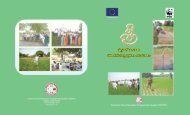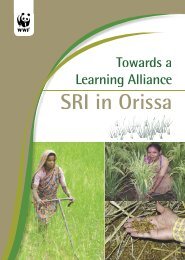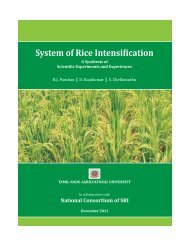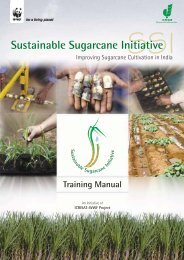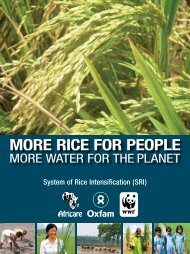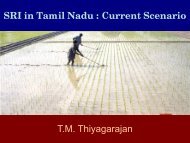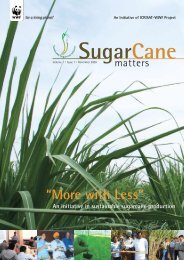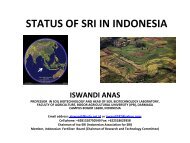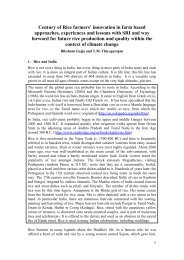Cost-Benefit Analysis of SRI Technology in Paddy Cult. - SRI - India
Cost-Benefit Analysis of SRI Technology in Paddy Cult. - SRI - India
Cost-Benefit Analysis of SRI Technology in Paddy Cult. - SRI - India
Create successful ePaper yourself
Turn your PDF publications into a flip-book with our unique Google optimized e-Paper software.
COST - BENEFIT ANALYSIS OF<br />
<strong>SRI</strong> TECHNIQUE IN PADDY CULTIVATION<br />
M. ANJUGAM, Assoc. Pr<strong>of</strong>essor<br />
S.VARADHA RAJ, Asst. Pr<strong>of</strong>essor<br />
S. PADMARANI, Asst. Pr<strong>of</strong>essor<br />
Dept. <strong>of</strong> Agricultural Economics, TNAU,<br />
Coimbatore<br />
1
TAMIL NADU ECONOMY<br />
> 60% <strong>of</strong> state population depend on agriculture<br />
13% <strong>of</strong> state <strong>in</strong>come is contributed by agriculture<br />
Net sown area is 62.59 lakh ha, which accounts for<br />
37.5% <strong>of</strong> the geographical area<br />
85-90% <strong>of</strong> the farm<strong>in</strong>g community, <strong>in</strong> terms <strong>of</strong><br />
numbers and area, are marg<strong>in</strong>al and small farmers<br />
Area under paddy is 20 lakh ha with average yield<br />
<strong>of</strong> 2,777 kg/ha<br />
<strong>Paddy</strong> production accounts for 3/4 <strong>of</strong> the state’s<br />
total food gra<strong>in</strong> production<br />
2
<strong>SRI</strong> INITIATIVES IN TAMIL NADU<br />
Experiments started <strong>in</strong> Coimbatore (TNAU)<br />
<strong>in</strong> 2000-2002; 2002; cont<strong>in</strong>ued at Killikulam<br />
AC&RI (TNAU) <strong>in</strong> 2003-2004<br />
2004<br />
On average, 53% less irrigation water was<br />
used, with gra<strong>in</strong> yield <strong>of</strong> 3,892 kg/ha,<br />
28% higher than conventional methods<br />
On-farm trials <strong>in</strong> Tamiraparani bas<strong>in</strong> <strong>in</strong><br />
southern Tamil Nadu (N=100): mean <strong>SRI</strong><br />
gra<strong>in</strong> yields were 1.57t/ha higher; gra<strong>in</strong><br />
yields over 8 t/ha recorded by 31 farmers<br />
(Thiyagarajan, 2006)<br />
Dept.<strong>of</strong> Agricultural Economics,<br />
TNAU, Coimbatore 3
Contd..<br />
TNAU has recommended <strong>SRI</strong> as a<br />
technology <strong>in</strong> Tamil Nadu to <strong>in</strong>crease rice<br />
productivity and save irrigation water<br />
The State Department <strong>of</strong> Agriculture held<br />
demonstration trials <strong>in</strong> all rice-grow<strong>in</strong>g<br />
areas <strong>of</strong> the state beg<strong>in</strong>n<strong>in</strong>g <strong>in</strong> 2004<br />
Government plans to br<strong>in</strong>g an additional<br />
area <strong>of</strong> 7.5 lakh ha under <strong>SRI</strong> cultivation<br />
<strong>in</strong> Tamil Nadu dur<strong>in</strong>g 2008-09 09 (accord<strong>in</strong>g<br />
to Policy Note, 2007-08<br />
08)<br />
Dept.<strong>of</strong> Agricultural Economics,<br />
TNAU, Coimbatore 4
Objectives <strong>of</strong> Study<br />
To identify the reasons for adoption <strong>of</strong> <strong>SRI</strong><br />
technique by farmers<br />
To assess the economic feasibility <strong>of</strong> <strong>SRI</strong> technique<br />
over conventional paddy cultivation, and<br />
To identify the constra<strong>in</strong>ts to adoption <strong>of</strong> <strong>SRI</strong><br />
technique and to suggest suitable policy measures<br />
to enhance rice productivity <strong>in</strong> Tamil Nadu<br />
Dept.<strong>of</strong> Agricultural Economics,<br />
TNAU, Coimbatore 5
Sampl<strong>in</strong>g<br />
Western Zone <strong>of</strong> Tamil Nadu was selected<br />
One block per district was selected, namely Pollachi<br />
and Sathyamangalam blocks <strong>in</strong> Coimbatore and<br />
Erode, respectively<br />
Structured <strong>in</strong>terviews scheduled - <strong>in</strong>formation on<br />
cost, <strong>in</strong>come, reasons for adoption, and the<br />
constra<strong>in</strong>ts <strong>in</strong> adoption <strong>of</strong> the technology was<br />
collected.<br />
This <strong>in</strong>formation was collected from 30 farmers who<br />
adopted the technique (adopters) and 30 farmers<br />
who are not adopt<strong>in</strong>g the technique (non-adopters)<br />
Data perta<strong>in</strong>ed to the crop year 2007-08<br />
08<br />
Dept.<strong>of</strong> Agricultural Economics,<br />
TNAU, Coimbatore 6
Tools <strong>of</strong> <strong>Analysis</strong><br />
Average and percentage analysis<br />
Reasons for adoption <strong>of</strong> <strong>SRI</strong> technique<br />
and the constra<strong>in</strong>ts encountered by<br />
farmers were measured by the Garrett<br />
Rank<strong>in</strong>g Technique<br />
Dept.<strong>of</strong> Agricultural Economics,<br />
TNAU, Coimbatore 7
Contd..<br />
Per cent position =<br />
n<br />
∑<br />
j=<br />
1<br />
(R<br />
ij<br />
−0.5)<br />
N<br />
j<br />
x 100<br />
Where:<br />
Rij = Rank given for i th item by the j th<br />
<strong>in</strong>dividual<br />
Nj = Number <strong>of</strong> items ranked by the j th<br />
<strong>in</strong>dividual<br />
Dept.<strong>of</strong> Agricultural Economics,<br />
TNAU, Coimbatore 8
Partial budget<strong>in</strong>g:<br />
Contd.<br />
To estimate the cost and returns <strong>of</strong> mak<strong>in</strong>g<br />
changes <strong>in</strong> the exist<strong>in</strong>g farm bus<strong>in</strong>ess<br />
In the present study, data were gathered to<br />
evaluate the efficiency <strong>of</strong> adopt<strong>in</strong>g <strong>SRI</strong> techniques<br />
(chang<strong>in</strong>g the method <strong>of</strong> plant<strong>in</strong>g) by replac<strong>in</strong>g<br />
the conventional methods <strong>of</strong> plant<strong>in</strong>g <strong>in</strong> paddy<br />
cultivation<br />
If the net ga<strong>in</strong> is positive, , this gives <strong>in</strong>centives to<br />
farmers to decide on adopt<strong>in</strong>g <strong>SRI</strong> techniques<br />
Dept.<strong>of</strong> Agricultural Economics,<br />
TNAU, Coimbatore 9
RESULTS AND DISCUSSION……<br />
Dept.<strong>of</strong> Agricultural Economics,<br />
TNAU, Coimbatore 10
General characteristics <strong>of</strong> sample farmers<br />
i. . Age <strong>of</strong> the farmer (years)<br />
Non – adopters<br />
(n=30)<br />
No.<br />
Frequency<br />
No.<br />
Adopters<br />
(n=30)<br />
Frequency<br />
< 40 8 0.27 2 0.07<br />
41-60<br />
10 0.33 24 0.80<br />
>60 12 0.40 4 0.13<br />
ii. Educational status<br />
Illiterates 2 6.67 .. ..<br />
Literates : i) School educ. 26 86.67 10 33.33<br />
ii) Degree 2 6.67 20 66.67<br />
iii. Family size (number)<br />
4.13 3.66<br />
Dept.<strong>of</strong> Agricultural Economics,<br />
TNAU, Coimbatore 11
Contd.<br />
Majority <strong>of</strong> <strong>SRI</strong> farmers fall <strong>in</strong> the age<br />
group <strong>of</strong> 41-60 years, whereas above 60<br />
years old were higher <strong>in</strong> non-adopters.<br />
67 % <strong>of</strong> <strong>SRI</strong> adopters were degree<br />
holders.<br />
Size <strong>of</strong> the family <strong>in</strong> non-adopters (4.13)<br />
is higher than adopters (3.66).<br />
The results <strong>in</strong>dicated that farmers who are <strong>in</strong> an<br />
active age group and more highly educated are<br />
more likely to adopt the technique.<br />
Dept.<strong>of</strong> Agricultural Economics,<br />
TNAU, Coimbatore 12
Operational hold<strong>in</strong>g<br />
Non-adopters<br />
No.<br />
% to<br />
total<br />
No.<br />
Adopters<br />
% to<br />
total<br />
Marg<strong>in</strong>al farmers (< 1 ha) 2 6.67 6 20.00<br />
Small farmers (1-2ha)<br />
12 40.00 4 13.33<br />
Medium farmers (2-4 4 ha) 14 46.66 6 20.00<br />
Semi-medium medium farmers ( 4 -10<br />
ha ) 2 6.67 14 46.67<br />
Large farmers (> 10ha) .. .. ..<br />
Mean 2.11 3.5<br />
% <strong>of</strong> paddy area to total<br />
operational area<br />
Operational hold<strong>in</strong>g<br />
62.50 45.50<br />
Dept.<strong>of</strong> Agricultural Economics,<br />
TNAU, Coimbatore 13
Canal and well irrigation<br />
Contd..<br />
Size <strong>of</strong> the hold<strong>in</strong>g is 2.11 and 3.5 ha <strong>in</strong><br />
non-adopters and adopters respectively<br />
Medium to semi medium farmers accounted<br />
for the 2/3 rd <strong>in</strong> the total sample i.e. 67% <strong>in</strong><br />
case <strong>of</strong> <strong>SRI</strong> adopters<br />
% <strong>of</strong> area under to paddy to the total land<br />
hold<strong>in</strong>g was 62.5 and 45.50 <strong>in</strong> case <strong>of</strong> non-<br />
adopters and adopters respectively<br />
Small and medium sized farmers are show<strong>in</strong>g<br />
will<strong>in</strong>gness to adopt new techniques and allocate<br />
more area for new technique if it suits the local<br />
condition.<br />
Dept.<strong>of</strong> Agricultural Economics,<br />
TNAU, Coimbatore 14
Adoption <strong>of</strong> <strong>SRI</strong> practices<br />
66.67 % <strong>of</strong> farmers adopted <strong>SRI</strong> technique<br />
from the tra<strong>in</strong><strong>in</strong>g <strong>of</strong>fered by the Dept. <strong>of</strong><br />
Agriculture followed by the Agricultural<br />
University (20%) & IAMWARM Project.<br />
60% <strong>of</strong> farmers adopted <strong>SRI</strong> only <strong>in</strong> the past<br />
6 months (one season) and 20% <strong>of</strong> the<br />
farmers adopted this technique for the past 2<br />
years.<br />
60% <strong>of</strong> farmers adopted <strong>SRI</strong> technique <strong>in</strong> the<br />
2 nd season (Nov to Feb) - No<br />
assured<br />
irrigation from the canal dur<strong>in</strong>g the 1 st<br />
season (kuruvai).<br />
Dept.<strong>of</strong> Agricultural Economics,<br />
TNAU, Coimbatore 15
ADT - 37<br />
ADT - 39<br />
ADT - 43<br />
ADT - 45<br />
ASD - 16<br />
BPT - 5204<br />
CO - 43<br />
White Ponni<br />
CORH 3 F1<br />
IR 20<br />
20<br />
15<br />
10<br />
5<br />
0<br />
NON-<strong>SRI</strong> <strong>SRI</strong><br />
Varietal Adoption <strong>in</strong> Study area<br />
Dept.<strong>of</strong> Agricultural Economics,<br />
TNAU, Coimbatore 16<br />
ADT - 36<br />
AREA IN ACRE
Contd..<br />
The major preferred paddy varieties adopted were:<br />
- ADT45 (30.5%) and ASD16 (24.5%) <strong>in</strong> the case <strong>of</strong><br />
Non-adopters<br />
- ADT45 (26.1%) and ADT43 (25%) <strong>in</strong> the case <strong>of</strong><br />
Adopters<br />
- CORH3 hybrid is also cultivated <strong>in</strong> many <strong>SRI</strong><br />
farms.<br />
Dept.<strong>of</strong> Agricultural Economics,<br />
TNAU, Coimbatore 17
<strong>SRI</strong> farmer practices vs. conventional paddy<br />
cultivation - A comparison<br />
Input<br />
Conventional<br />
<strong>Paddy</strong><br />
Seed 20-30 kg per<br />
acre<br />
Spac<strong>in</strong>g<br />
Transplant<strong>in</strong>g<br />
No. <strong>of</strong> seedl<strong>in</strong>gs<br />
per hill<br />
Closer spac<strong>in</strong>g<br />
15X10, 20X10,<br />
20X20<br />
Seedl<strong>in</strong>gs<br />
about 30 days<br />
old<br />
<strong>SRI</strong> technique –<br />
recommended<br />
2-33 seedl<strong>in</strong>gs Only one<br />
seedl<strong>in</strong>g<br />
<strong>SRI</strong> – Farmer<br />
practice<br />
2 kg per acre 21 kg per acre<br />
25 X 25 cm Not all <strong>of</strong><br />
them practiced<br />
8-14 days old 20-25<br />
25 th day<br />
1-22 seedl<strong>in</strong>gs<br />
Dept.<strong>of</strong> Agricultural Economics,<br />
TNAU, Coimbatore 18
CONTD..<br />
Input<br />
Fertilizers<br />
Plant<br />
protection<br />
Conventional<br />
<strong>Paddy</strong><br />
Application <strong>of</strong><br />
chemical<br />
fertilizers,<br />
<strong>in</strong>secticides and<br />
herbicides<br />
Application <strong>of</strong><br />
<strong>in</strong>secticides and<br />
herbicides,<br />
2-33 times spray<br />
<strong>SRI</strong> technique –<br />
recommended<br />
Preference given<br />
to organic<br />
fertilization,<br />
<strong>in</strong>secticides and<br />
herbicides<br />
Insecticides,<br />
pesticides are<br />
not necessary<br />
<strong>SRI</strong> – Farmer<br />
practice<br />
Mostly chemical<br />
fertilizers are<br />
used<br />
One time spray<br />
is followed when<br />
required<br />
Weed<strong>in</strong>g<br />
Manual<br />
weed<strong>in</strong>g,<br />
herbicide<br />
application<br />
(Source: Primary Survey)<br />
Non-chemical<br />
means <strong>of</strong> weed<br />
control by cono-<br />
weeder (2 times )<br />
Cono-weeder (2<br />
times) + manual<br />
weed<strong>in</strong>g (2 times)<br />
Dept.<strong>of</strong> Agricultural Economics,<br />
TNAU, Coimbatore 19
Factors <strong>in</strong>fluenc<strong>in</strong>g Adoption <strong>of</strong> <strong>SRI</strong> technique<br />
Reasons for adoption Score Rank<br />
M<strong>in</strong>imum seed requirement 74 I<br />
Low nursery duration 57 II<br />
To obta<strong>in</strong> subsidy 52 III<br />
Low nursery cost 51 IV<br />
Less cost <strong>of</strong> cultivation 43 V<br />
Low labour requirement 37 VI<br />
Motivation by Extension <strong>of</strong>ficials 35 VII<br />
Dept.<strong>of</strong> Agricultural Economics,<br />
TNAU, Coimbatore 20
Operational cost <strong>SRI</strong> adopters Non –adopters T-value<br />
<strong>Cost</strong> (ha) % <strong>Cost</strong> (ha) %<br />
Nursery preparation 688 2.05 1,083 3.00 1.51 ***<br />
Ma<strong>in</strong> field preparation &<br />
transplant<strong>in</strong>g<br />
9,612 28.60 10,521 29.10 0.98<br />
Seed 301 0.90 1,447 4.00 26.19*<br />
Fertilizers 3,643 10.84 4,025 11.13 1.25<br />
Irrigation 1,600 4.76 1,890 5.23 1.66**<br />
Weed<strong>in</strong>g 4,769 14.19 2,866 7.93 -3.30*<br />
Plant protection<br />
chemicals<br />
642 1.91 985 2.73 2.07**<br />
Harvest<strong>in</strong>g and thresh<strong>in</strong>g 11,589 34.48 12,511 34.61 0.64<br />
Interest on work<strong>in</strong>g<br />
capital<br />
766 2.28 824 2.28<br />
Operational cost 33,610 100 36,153 100 1.20<br />
Dept.<strong>of</strong> Agricultural Economics,<br />
TNAU, Coimbatore 21<br />
*significant at 1 %, ** significant at 5%; *** significant at 10%
Comparative <strong>Analysis</strong> <strong>of</strong> Income – <strong>SRI</strong> Technique over<br />
Conventional <strong>Paddy</strong> <strong>Cult</strong>ivation (Rs. per ha)<br />
<strong>SRI</strong><br />
adopters<br />
Non –<br />
adopters<br />
T-value<br />
Gra<strong>in</strong> product (Qtls) 67.23 54.00 4.42 *<br />
Price realized by the farmer (Rs.) 842.67 811.33<br />
Value <strong>of</strong> gra<strong>in</strong> product (Rs.) 57,034.93 43,643.48<br />
Straw by-product (Qtls) 50.83 48.95<br />
Price realized by the farmer (Rs.) 159.33 124.33<br />
Value <strong>of</strong> straw by-product 7,871.07 5,471.44<br />
Gross <strong>in</strong>come 64,906.00 49,114.92 4.22*<br />
Operational cost 33,609.54 36,153.06<br />
Net <strong>in</strong>come over operational cost<br />
31,296.46 12,961.86 4.05*<br />
Output: <strong>in</strong>put ratio 1.93 1.36<br />
Dept.<strong>of</strong> Agricultural Economics,<br />
TNAU, Coimbatore 22
<strong>Analysis</strong> <strong>of</strong> economic impact <strong>of</strong> <strong>SRI</strong> technique: Partial budget<strong>in</strong>g<br />
Increased Return<br />
Credit (Ga<strong>in</strong>s) Amount (Rs.) Debit (Loss) Amount (Rs.)<br />
Gra<strong>in</strong> product: 13 Q/ha @ Rs. 842 /Q<br />
By-product: 2 Q/ha@ Rs. 150/Qt<br />
Reductions <strong>in</strong> <strong>Cost</strong><br />
11,140.00<br />
100.00<br />
Sub total 11,240.00<br />
Nursery preparation 396.00<br />
Ma<strong>in</strong> field preparation & transplant<strong>in</strong>g 909.00<br />
Seed 1,146.00<br />
Fertilizers 382.00<br />
Irrigation 290.00<br />
Plant protection 344.00<br />
Harvest<strong>in</strong>g 922.00<br />
Additional <strong>Cost</strong><br />
Weed<strong>in</strong>g 1,903.00<br />
Sub total 4,388.00 Sub total 1,903.00<br />
Total Ga<strong>in</strong> 15,628.00 M<strong>in</strong>us additional<br />
cost<br />
1,903.00<br />
Dept.<strong>of</strong> Agricultural Economics,<br />
TNAU, Coimbatore 23<br />
Net benefit (total ga<strong>in</strong> – additional cost) = Rs. 13,725
Constra<strong>in</strong>ts <strong>in</strong> adoption <strong>of</strong> <strong>SRI</strong> techniques<br />
Constra<strong>in</strong>ts Scores Rank<br />
Difficulty <strong>in</strong> use <strong>of</strong> conoweeder<br />
58.06 I<br />
Lack <strong>of</strong> technical support from<br />
the extension <strong>of</strong>ficials<br />
57.67 II<br />
Health problems due to<br />
operation <strong>of</strong> conoweeder 47.06 III<br />
Lack <strong>of</strong> awareness among the<br />
labourers about <strong>SRI</strong> technique<br />
37.22 IV<br />
Dept.<strong>of</strong> Agricultural Economics,<br />
TNAU, Coimbatore 24
Conclusions<br />
Power-operated<br />
operated cono-weeder<br />
us<strong>in</strong>g either<br />
battery or diesel may be supplied to farmers<br />
for more efficient weed<strong>in</strong>g so as to <strong>in</strong>crease<br />
the productivity <strong>of</strong> labourers<br />
Skill-oriented tra<strong>in</strong><strong>in</strong>g should be given to<br />
agricultural labourers regard<strong>in</strong>g <strong>SRI</strong><br />
practices<br />
This will def<strong>in</strong>itely help farmers to adopt the<br />
new techniques <strong>in</strong> a larger way to <strong>in</strong>crease<br />
the productivity and net <strong>in</strong>come at farm level<br />
Also, this technique will be a better solution<br />
to meet<strong>in</strong>g food demand<br />
Dept.<strong>of</strong> Agricultural Economics,<br />
TNAU, Coimbatore 25
Dept.<strong>of</strong> Agricultural Economics,<br />
TNAU, Coimbatore 26



